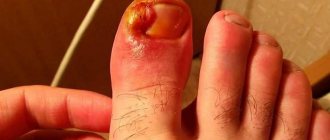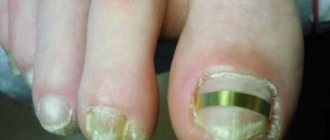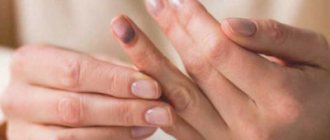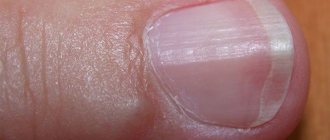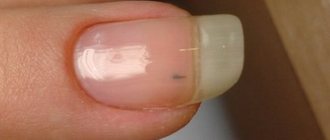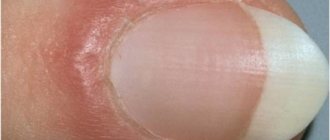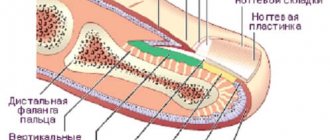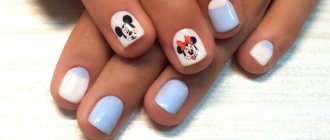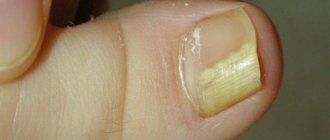How to treat a crushed toe
Following the dictates of fashion, many women, and men too, purchase shoes that are not only uncomfortable, but also cause serious damage to the health of their feet. As a result, nails are injured by shoes, as a result of compression of the fingers, soft tissues and, of course, the nail plates.
If a person notices that the nail from tight shoes has turned blue, the skin around it has turned red and swollen, some measures need to be taken, including giving up uncomfortable shoes. Externally, an injury from squeezing a nail resembles an injury from a bruise - the nail becomes dark in color, swelling and redness occur around it. Probably, the capillaries supplying the finger with blood have burst, so the nail plate has turned blue or even turned black. The pain experienced by the patient is quite severe and throbbing; it can last for 6 hours or more. The blood accumulating under the nail puts pressure on it, and it may seem to the person that the finger is about to burst.
To alleviate the condition of an injured person, you need to put a cold compress or ice on the sore spot, changing it as needed. Experts recommend preparing a decoction of chamomile, cooling it and using it for compresses. You should know that you need to release the blood from under the nail to prevent it from peeling off. This is usually done in a hospital, but if it is not possible to visit the emergency room at the moment, the procedure can be done at home. An ordinary needle is taken, disinfected with alcohol or heated over a fire, and the nail plate is punctured.
You need to carefully monitor the condition of the nail and the soft tissues around it; if suppuration appears, the swelling does not subside, but becomes larger, you need to consult a doctor. If the nail turns blue from shoes, we can talk about an injury that requires the person not to wear any shoes or even sneakers for some time, so as not to harm himself even more. It is advisable to take baths with cold water in which sea or regular table salt is dissolved. Such procedures should be done 2 or 3 times a day; they relieve pain and swelling well.
Such problems are quite common among people who play sports professionally, especially football players and runners. This happens because the nail constantly rubs against the inner surface of the shoe, and football players have to often kick the ball. Having cured the damage, the person begins training and soon gets the same problem. Experts recommend taping your toes before exercising, or choosing boots or sneakers with a hard front that protects your toenails from impact, pressure, and friction.
After squeezing a nail with tight shoes, it is quite possible that the nail plate will peel off and a new one will grow in its place. If the damaged nail has been surgically removed, all that remains is to be careful not to injure the nail bed and prevent suppuration. If such an operation was not performed, then the damaged plate is lifted, and a new one grows under it. Sharp edges can catch on anything, including socks, so you need to protect your fingers with adhesive tape. After growth, the nail may be wavy or lumpy, but after some time, a beautiful and smooth nail will begin to grow, if, of course, the inflammatory process on the nail bed has been avoided.
Due to tight and uncomfortable shoes, the effect of squeezing the nail may occur, which leads to a hematoma under the nail plate; such an injury is accompanied by pain and swelling. Treatment is carried out in the same way as in the case of a bruised toe, that is, cold compresses are made, ice is applied and blood is released from under the nail plate.
The main causes of pain under or near the nail beds
Various reasons can cause discomfort and pain in or near the nail plates of the thumb and other fingers, and why this happens is discussed in detail below.
Diseases
You can become infected with it through contact with surfaces on which the fungus “lives”:
The situation can be aggravated by improper care of the skin of the feet, as a result of which the epithelium hardens, turning into calluses, or is destroyed, becoming a favorable environment for bacteria and fungi. When affected by pathogenic microflora, the nail changes its color and structure, the skin around it becomes inflamed, and often begins to peel off.
The main diseases that cause nail problems include:
Onychomycosis
If this disease is ignored, the nail plate thickens and changes color, stripes or spots appear on it (normotrophic type), and in a neglected state, it is completely separated from the skin of the finger (hypertrophic type). Lesions may be localized on one or several nails.
Rubromycosis
The fungus red trichophyton affects the nail plates, making them thin, brittle and painful.
Candidiasis
Microcracks in the nail plates, as well as microcuts caused by pedicures, are an ideal environment for the proliferation of fungi of the genus Candida. Subsequently, swelling of the toes, their soreness, and inflammation of the skin around the nail develop.
Ringworm
As a result - a change in its color, compaction.
Athlete's foot
Causes inflammation and discoloration of the nail, skin and soft tissue around it.
Felon
A disease caused by the active proliferation of pyogenic bacteria. They enter the body through small wounds or cracks in the nail plate or epithelium. An increase in their number causes the development of the inflammatory process and the occurrence of painful sensations.
Onchocryptosis
A disease caused by the ingrowth of a nail into the skin of the finger. Along with mechanical reasons, fungal infections can also cause such an anomaly.
Such conditions require serious drug therapy, physical therapy, and diet: getting rid of pain by relieving only unpleasant symptoms will not work; relief will only be temporary.
Venereal and skin diseases can provoke pain in the toenails: gonorrhea, syphilis, psoriasis. Pain relief will be effective only if a true diagnosis is established and adequate treatment is prescribed.
Mechanical damage if the nail plate turns blue, darkened or blackened
Most often, pain in the nail develops due to mechanical damage received:
Sometimes, with a particularly strong blow, you can notice an accumulation of blood under the nail, turning it black or dark blue. Subsequently, part of the nail plate may “peel off”, but this will take a long time (from a month to three).
Artificial, airtight materials create a greenhouse effect inside, promoting the growth of bacteria. High heels and narrow toes can significantly damage the reputation of a high-quality pair of shoes: they can only be worn periodically without harm to health.
When you put on a new pair of shoes or boots, listen to how you feel. Fatigue, pain, a feeling of tightness, swelling and tension in the feet and legs up to the knees are a signal that it is better to change shoes.
Most often, the nails on the big toes suffer from this problem, deformed from prolonged wearing of tight shoes, unsuccessful pedicures, or developing due to a genetic predisposition. In severe cases, people cannot stand on their feet or take even a step; ignoring this condition can lead to gangrene.
Bruised nail: home treatment methods
A bruised toenail is a very common injury. There are many different options for getting it, so it is almost impossible to prevent such an injury. For example, a bruised nail can be caused by an impact if something heavy falls on the leg. The duration of the entire treatment will depend on the timeliness of first aid. Therefore, you need to know what to do with a bruised nail if such an unpleasant situation occurs.
Toenails hurt: what to do
Fungal infection, injury or inflammation is not a complete list of conditions that cause pain in toenails. A number of causes of pain can be eliminated on your own by giving up uncomfortable shoes or regular pedicures using chemicals. If the color or shape of the nail plate changes, rashes appear on the skin around it and an unpleasant odor, ichor or pus is discharged, you must consult a doctor to determine and eliminate the factor causing these symptoms.
Types of bruises
Statistics show that in general the majority of bruises occur on the legs. Quite often, the nail suffers, under which a hematoma forms. A bruised toenail is a very common occurrence. Quite often, patients in such cases do not seek help from a medical facility, but try to treat the injury themselves at home. However, a bruised nail can be a very serious injury, which in some cases requires medical attention.
Depending on the force of the blow, pain varies in degree. A mild bruise to the thumbnail, for example, will cause only minor pain while walking. If the injury was serious, then it is accompanied by severe pain during movement, and swelling may form on the nail.
In case of a slight bruise of the big toe nail, you only need to apply something cold to the nail plate in time. As a rule, in such situations, the injury goes away very quickly if special herbal compresses are used.
If there was a severe bruise of the nail, then in such situations the nail plate becomes dark, and there is also a possibility of deformation of the finger and rejection of the entire nail. In such situations, there is no way to do without the help of a specialist.
Regarding the severity of nail bruises, they are usually divided into four groups:
Therapy
The first step in case of injury or bruise is to apply ice or something cold to the damaged area: this will prevent the appearance of a hematoma or at least reduce its size. If the pain is severe, you can give the victim a painkiller.
If frostbite is suspected, the victim must be warmed up as quickly as possible. A bath, foot bath, massage, intense rubbing will do. In the case of tight and uncomfortable shoes, you need to activate blood flow. This can be done with a foot bath with salt and subsequent massage using cosmetic oil.
At elevated temperatures, vascular spasm can cause disturbances in the body's heat exchange, which leads to changes in the color of the toenails. In this case, you can take no-shpa, actively rub the limbs and give the patient more warm drinks.
Treatment of a bruised nail
If there was a severe bruise, then treatment should be prescribed by a doctor. For minor injuries, therapy is carried out independently at home. To do this, you can use a variety of folk methods. If the nail begins to peel or there is a tear, surgery may also be required. For rehabilitation purposes, various physiotherapeutic procedures are used. This should include UHF, electrophoresis and magnetic therapy, which will contribute to the rapid resorption of the formed hematoma, as well as the rapid healing of damaged tissue under the nail.
Folk remedies
Many people are interested in how to restore nails at home. After removing a nail, you can use folk remedies for quick healing, relief of inflammation and pain. Before using the product, it is better to consult a doctor and make sure that there is no allergy to its components. It is also not recommended to mix pharmaceutical and folk remedies with each other; they must be applied one at a time. Useful recipes:
- Herbal baths have excellent healing and anti-inflammatory effects. As soon as the wound heals, you can carry out this procedure 2-3 times a week. To do this, brew a herb, for example, chamomile, sage or string, filter the decoction and pour it into warm water. The feet are immersed in the bath for 15 minutes.
- When the nail has already begun to grow, natural salt baths will help strengthen it. For 500 ml you need to take 4 tablespoons of natural sea salt without dyes and flavors. Repeat the procedure 3 times a week.
- 2 times a week you need to apply iodine to the cuticle with a cotton swab in a thin layer. This product will help speed up the growth of nails and make them healthy and beautiful.
- To make a weak nail strong, you need to lubricate it every day with grape seed oil or natural olive oil, you can also add essential oils, such as orange.
- If the nail grows very slowly, it is thin and peeling, a lemon mask will help. To do this, apply a piece of lemon to the nail and secure it with a bandage, leave for 15 minutes, then rinse the skin with water.
It is important to note that all folk remedies can be used only after the wound has completely healed. Until this moment, the nail bed should be covered with a sterile bandage, and only ointments, for example, levomikol, can be applied to the wound, and only if this is recommended by the doctor.
Treatment at home
Self-medication at home is allowed only in cases where the injury occurred without complications and there is no dislocation or fracture. If the nail is severely damaged, it is imperative to seek help from the trauma department. If this is not done in time, then there is a high probability of serious consequences, which may even include amputation of a finger. There are a number of cases in which it is simply impossible to do without specialized medical care:
Recipes
If all these symptoms are absent, then you can begin self-medication using folk remedies 2 days after the injury. As a rule, lotions from the following herbs are used for treatment:
These plants are effective in combating bruises due to their disinfectant and analgesic properties. To prepare a compress, you need to take all these herbs in equal proportions, pour one glass of boiling water over the mixture, and then let it brew for an hour. Drain the liquid, and apply the resulting mixture in the form of a paste as a compress on the affected areas of the finger overnight.
Plantain is also very effective, as it heals various bruises well. To do this, the leaf of the plant must be peeled, after which it must be applied to the affected area. This procedure must be repeated every 20 minutes.
Tips and tricks for stubbed toe - do's and don'ts?
This trauma accompanies us throughout our lives. Hurry up. Or went to the toilet in the dark, half asleep. Or it’s already dark - but with bleary eyes. Or even in a completely awake state and with eyes wide open - but in an unfamiliar place.
And here it is: a high threshold, or an insidiously protruding corner of furniture, or a hard suitcase forgotten in a hurry, or a chair placed around the corner at the wrong time. Or on a hot summer afternoon, they didn’t put on shoes or boots that covered their feet on all sides, but light sandals, in which the granite curb awaited their feet on the street. Ready!
You hopped on one leg, holding the other in your palm, hissing as you sucked in air through your teeth or using obscene language. And then, when the first painful shock subsides, you begin to assess the damage done to yourself.
And here are the possible options...
Severity of injury
We seem to be moving slowly, at a normal pace. However, the speed of the foot at the moment the toe hits a hard surface is approximately 50 km/h. Now imagine that you are in a car moving at such a speed, and suddenly you fit into a pole? Mentally assess the nature of the damage to the car and your injuries if you were not wearing a seat belt?
Therefore, the severity of injuries can be roughly designated as four degrees:
The four described conditions after being hit by a finger or on a finger can be considered typical, widespread. However, there are individual reactions. For example, a state of shock, when at first no pain is felt, usually lasts minutes or even seconds.
But for some people with a special type of nerve conduction, it can last for tens of minutes or even hours. Therefore, it is very important after receiving an injury to carefully examine the affected area and carefully palpate and examine the phalanges, nails and joints of the toes.
First aid
Anyone can evaluate an injury using the signs of the four listed conditions. And in accordance with your own feelings, begin to provide first aid to yourself.
As a rule, bruises of the first two degrees of severity can be cured at home if you follow some rules.
Difficulties may arise in the event of injury of the third and, especially, fourth degree of severity. With the third, even if there is no crack in the bone or fracture, damage to nerve endings, muscles and, most unpleasantly, tendons is possible. It is no longer possible to do without medical assistance, expressed in the application of a plaster cast with partial immobilization of the finger joints.
Even more serious consequences can occur with a fracture, when hospitalization is not only desirable, but also vital: because of such a “trifle” as a toe, you can get lifelong disability. Why?
Most common injuries
Thumb
When speaking of a “bruised toe,” most often they mean a bruise of the big toe, both the one that protrudes the most beyond the line of all the others, and the one with the largest area of contact. And no less rare than a bruise due to tripping over an obstacle, heavy objects fall on this finger.
As a consequence, an almost obligatory extensive hematoma affecting the nail, as well as the first and second (large) joints. The severity of the injury depends on the height of the fall and the weight of the object. The heavier the object or the greater the height of its fall, the more serious the damage to the finger.
For injuries of this kind, it is better to consult a doctor already at the 3rd degree of damage, because the injured joint will make itself felt over the years by the formation of a growth on the large joint and curvature of the finger towards all the others, provided that timely and intensive medical care is not provided on time.
The thumbnail subsequently, with lesions of degrees 3 and 4, peels off in 90% of cases, often with suppuration under the nail plate. So it has to be removed, and this procedure is very painful.
Therefore, if the nail turns blue or black, you need to immediately glue it and fix it with a large adhesive plaster - then, perhaps, there is a chance that it will grow back after the hematoma underneath it resolves. Or it will separate the finger “dry”, painlessly.
Second finger or little finger
The little finger most often suffers from the corners and legs of furniture, as well as door frames, into which a person does not fit in the dark or not quite waking up in the morning. The nail and large joint of the little finger suffer the most from blows when stuttering, which may in the future increase in size and give a curvature to the finger, similar to the case with the big one.
Treatment of the patient
Only a professional can name the exact cause of a nail problem, so a visit to a therapist or dermatologist is mandatory.
The specialist will determine why this or that problem has arisen with the nails of the thumb or other finger, where exactly the lesion is localized, near or under the nail plate, and will prescribe the necessary and effective treatment. Pain caused by wearing low-quality shoes will go away on its own immediately after changing them; pain resulting from a bruise or sloppy pedicure will go away as the wound heals or injured tissues recover.
Medication
If the cause of pain is a disease, then drug treatment cannot be avoided. The selection of medications is made only by a doctor on a purely individual basis, depending on the diagnosis, the severity of the disease and the characteristics of the patient’s body.
Therapy is carried out using the following drugs:
A particular danger is sepsis, a blood poisoning that can be fatal.
Folk remedies
Often, patients with nail pain problems resort to traditional medicine, and this is no coincidence: baths and compresses using natural ingredients help reduce the intensity of inflammatory processes, moisturize and relax the skin and nail plates, which cannot but affect their appearance and condition. .
The following recipes have gained particular popularity:
General recommendations
The failure of even one toe disrupts the balance of the foot; the victim, trying not to step on the sore spot, places his foot on the heel, without involving the toes, or on the left or right edge of the foot. The result is overstrain of individual muscle groups, pain in them, as well as in the ankle and intermetatarsal joints.
In the first hours after a bruise, in case of acute pain, you can take painkillers: analgin, ketarol, pentalgin. Aspirin is not recommended due to its blood thinning effect, which carries the risk of internal bleeding.
At the first stage of treatment of third and fourth degree injuries (and sometimes second), it is necessary to ensure rest of the sore foot, comprehensive treatment, and then, for a week or two, a gentle walking regime and comfortable, soft, non-pressure shoes made from natural materials.
If it is possible to take an x-ray, take one. He will show an accurate picture of the damage to the finger and help carry out the correct treatment.
If the doctor has prescribed physical procedures in the form of electrophoresis, magnetic and laser therapy, massage, then you should definitely take advantage of this opportunity. These actions are guaranteed to save you from problems in the form of post-traumatic complications in the future.
If it is recommended to have surgery, do not refuse. It is prescribed if there is a risk of infection that can spread to the tissue surrounding the injury site. In this case, conservative (medicinal) treatment will be ineffective, and the infection that has penetrated into the bone may go so far that amputation of the finger is required.
Timely surgery to clean the affected areas will help prevent such developments.
What to do for prevention?
A set of basic rules of hygiene and foot skin care can prevent most possible nail problems:
Nail pain requires attention and medical advice. Behind the imaginary insignificance of the problem, serious illnesses can be hidden, which are fraught with complications and even death. Timely drug treatment or surgical intervention can solve this issue, and in most cases a high level of personal hygiene can prevent it.
Source
